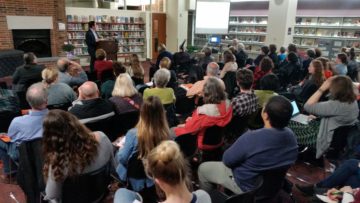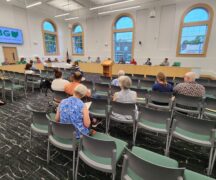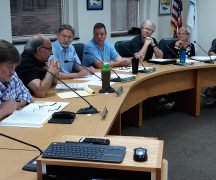By JAN LARSON McLAUGHLIN
BG Independent News
Bowling Green has declared itself a “welcoming community.” But what does that really mean? And how exactly can it be accomplished?
Earlier this year at the urging of the city’s Human Relations Commission, Bowling Green City Council adopted a resolution stating the city was welcoming.
“All communities say they are welcoming,” said Rev. Mary Jane Saunders, co-chair of the Human Relations Commission. “We always know any community can be better.”
The commission wants Bowling Green and its residents to view immigrants as a benefit – not a detriment to the community – and to realize the economics of immigration.
Several cities in the “rust belt” have started looking at immigrants in a different light than some areas of the nation. In many Midwest cities, immigrants are now seen as a solution to critical labor shortages and as ways to strengthen the local economy
Several manufacturers in Bowling Green have expressed concerns recently about the labor force being too small to fill their needs.
So last week, Bowling Green welcomed home Steve Tobocman, whose great-grandfather immigrated to this community in the beginning of the 20th century after fleeing the persecution of Jews in Russia. Tobocman is executive director of Global Detroit, which works to leverage international talent to fill businesses’ unmet needs, help immigrant entrepreneurs, revitalize neighborhoods, and build an inclusive region.
Tobocman, an attorney and former Michigan state legislator, complimented Bowling Green for taking the first step to becoming a truly welcoming community.
“I congratulate your group for what you have done already,” he said – stressing that it is a big step for a community like Bowling Green, which is made up of just 2 percent “newcomers.”
“To say that’s pretty profound,” Tobocman said of the city’s resolution.
The current political climate has stirred a lot of discussion about what it means to be an American, Tobocman said.
“Immigrant welcoming works best when it’s rooted in the national character,” he said. Immigrants and refugees “will be here beyond this temporary debate.”
But smart communities are talking about the “economics of welcoming.”
Tobocman works with several such cities in Michigan and Ohio.
“These are all communities that on their own have decided it is in their own self interest to be welcoming to immigrants and newcomers,” he said.
Many are larger cities with distressed economic centers – like Detroit. “They’ve all created their own niche” to attract newcomers.

Local residents listen to speaker talk about welcoming communities.
On the whole, America’s rust belt sees fewer immigrants. In the last 15 years, the rust belt population grew by 4 percent – compared to 15 percent for the overall nation.
Of the Midwest’s largest cities, most lost population from 1960 to 1980. The only cities to see a rebound were those that experienced major immigrant growth, Tobocman said.
Detroit is one of those rebound success stories, with the immigrant population jumping 13 percent in five years.
The benefits of a growing immigrant population are as follows, Tobocman said:
- Immigrants bring a younger workforce. The median workforce aged from 35 to 42 years old between 1978 and 2018. “We have a rapidly graying crisis,” Tobocman said.
- Unlike the “travel ban” talking points, immigrants to the U.S. are frequently highly educated. Statistics show that a resident of Ohio is more likely to have higher degrees if he or she is foreign born.
- International college students boost local economies. Ohio has 28,373 international students, including BGSU’s 711. Those students contribute an estimated $772 million a year to the state’s economy, he said.
- Many immigrants are in the critical STEM fields. Their work helps create jobs for others, Tobocman said. In some regions, as many as 70 percent of graduate students are from other nations.
- Immigrants are twice as likely to be entrepreneurs. “To immigrate is an entrepreneurial act itself,” Tobocman said. That entrepreneurial spirit by immigrants is seen in huge high-tech firms, and in shops on Main Street.
- Immigrant populations add excitement and diversity to communities – which helps attract millennials. For example, by setting up Indian or Mexican restaurants, they help attract young people who want more than chain restaurants.
But how can Bowling Green attract more immigrants? Each community has to come up with a plan that fits, Tobocman said.
Some cities have set up special job creation or homeownership programs. Some hold job fairs specifically to retain international students.
Dayton offers university certification and training programs for the immigrant workforce. The city organizes a big international soccer game each year. Toledo has created an international film festival, plus offers help connecting with services and learning a new language.
A welcoming center in Pennsylvania offers new arrivals help with career ladders, languages and entrepreneurship. St. Louis focuses on international student retention, and holds an annual festival of nations.
Though the political climate does not recognize it – immigration is the life-blood of many struggling communities, Tobocman said.
“The richest regions are those with the highest populations of immigrants,” stated Tobocman’s slide from the President’s Commission on Immigration in 1953.





